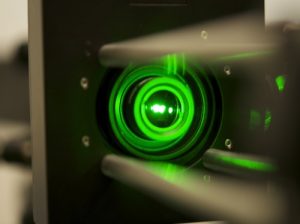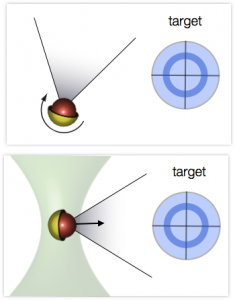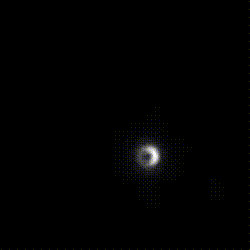Artificial Microswimmers

At length scales of micro- or nanometers, swimming becomes an almost impossible task as Brownian motion is shaking all microscopic swimmers and normal time-symmetric swimming movements cause no progress. At the micro scale, other mechanisms have to be found to transport objects actively. Evolution, for example, has brought up molecular motors, which are confined to tracks in cells to enable transport.
Here, we investigate new mechanisms which propel particles or which allow the trapping of molecules in solution. These mechanisms mainly involve temperature as one of the key parameters of Brownian motion. By generating temperature gradients in various geometries, we steer, trap and propel particles. Our research aims at the creation of small nanomachines and the development of artificially intelligent systems to uncover which information flows are required to create collective behavior which is essential for life. Further, a number of new phenomena of statistical mechanics are studied in these non-equilibrium systems.
Photon Nudging

Photon nudging is an advanced control technique for artificial micro-swimmers which we have developed with the group of Prof. Haw Yang at the Department of Chemistry at Princeton University. Due to the rotational Brownian motion of micro-swimmers, their directional motion only persists for a short time. To make the motion persistent, we harness for the first time thermal fluctuations in the spirit of a Maxwell demon. Photon nudging follows the orientation of single artificial  micro-swimmers in real-time to switch the propulsion of the micro-swimmer on or off depending on its orientation towards a target location. By doing that a motion much like the famous run-and-tumble motion of E-coli bacteria arise and the swimmer is able to steer along paths and to be localized on target positions.
micro-swimmers in real-time to switch the propulsion of the micro-swimmer on or off depending on its orientation towards a target location. By doing that a motion much like the famous run-and-tumble motion of E-coli bacteria arise and the swimmer is able to steer along paths and to be localized on target positions.
This technique is the foundation for all other swimmer control experiments in the group. It allows us to explore the interaction of a controlled number of particles to reveal what hydrodynamic and thermal interaction rules they obey.
Interactions of Swimmers

Artificial micro-swimmers are non-equilibrium systems which reveal various interesting dynamic structure formation processes as their physics is not longer bound to detailed balance as we know it from equilibrium physics. We explore the details of swimmer interactions by detailed control of their motion by photon nudging. We focus on self-thermophoretic swimmers and explore the contributions of temperature gradients, interfacial flows and propulsion itself to the structure formation process. We try to find fundamental governing laws describing the state of a swimmer ensemble.
Artificially Intelligent Swimmers
Living structures have the ability to adapt to environmental conditions. A cell is able to adjust its gene expression to the current situation and people and animals are able to learn about their environment on an individual or an evolutionary scale. We have introduced learning algorithms into the action of artificial swimmers. Using in particular reinforcement learning algorithms, our swimmers learn to navigate their “world” based on rewards. They show that noise is an important ingredient in the learning process and collective learning by sharing information speeds up the learning process considerably.

Information Flow and Artificial Swimmer Molecules

In living systems, information flow plays an important role for self-organization. A flock of birds, for example, adjusts to a certain density based on the interactions of individual swimmers which are not physical, but based on the information a bird acquires about the rest of the flock and how it responds to this information.
Here, we introduce similar information-based interactions between swimmers by constructing simple feedback rules between individual swimmers. These active particle molecules are highly dynamic structures determined in their properties by entropy flows.
